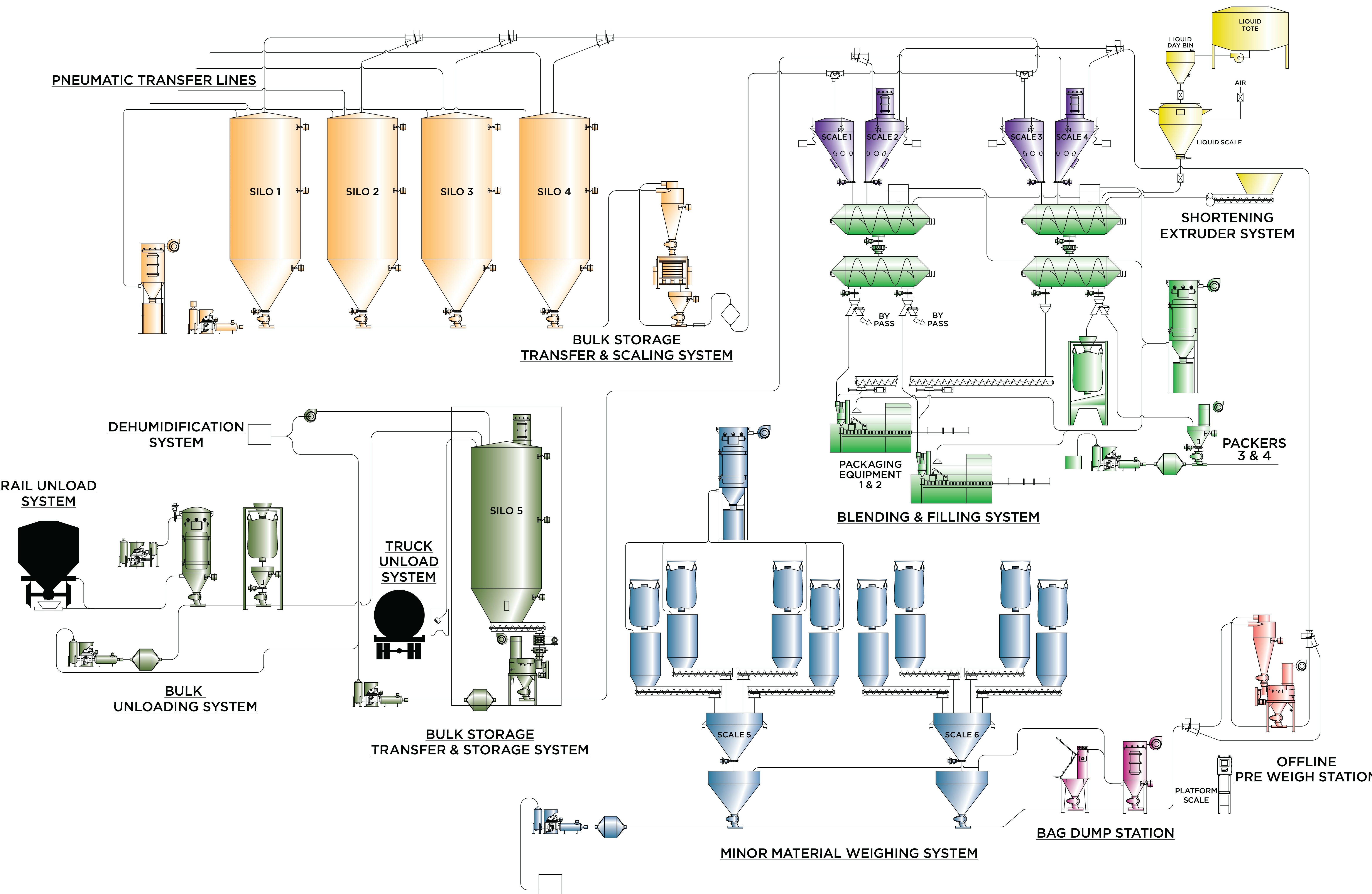A Holistic Approach to Industrial Automation for Complete Process Systems: Top Five Implementation Strategies
The quest for efficiency and productivity is relentless in the ever-evolving world of industrial process manufacturing. This is true in many industries from baking and food processing to animal feed and pet food manufacturing, compounding, and much more. Traditional process management methods gradually give way to sophisticated technologies that promise greater control, precision, and adaptability. One of the most transformative advancements in this field is adopting industrial process automation. However, to truly harness the potential of this technology and reap process automation benefits, companies need to embrace a holistic approach to automation that integrates all components of their process systems.
A Complete Process System
A complete process system is a comprehensive, integrated setup that manages every stage of your process production from start to finish. It begins with inputs like raw materials and energy. It includes process control using a variety of sensors and automation to monitor and regulate numerous process variables such as weight, temperature, flow, pressure, and more. The process system incorporates machinery for process production tasks, such as batching and dosing, quality control for ensuring product standards, and data collection for performance monitoring and integration with your business systems for analytics and decision-making.

Integration and communication between components and systems are crucial for a unified operation, while support systems handle maintenance, safety, and environmental concerns. The human-machine interface, control panels, and software allow operators to manage the process effectively. These control panels incorporate a variety of electrical drives and power controls, PLCs, industrial PCs, associated I/O devices, and the operator interface.
This holistic approach offers several benefits: it enhances efficiency by synchronizing all process parts, ensures consistent quality through integrated controls, and provides flexibility to adapt to changes. Additionally, it leverages data for continuous improvement and reduces downtime with effective maintenance. Overall, a complete system ensures process automation benefits, such as ensuring smooth, efficient, and reliable production operations from start to finish.
Understanding Industrial Automation
Industrial automation refers to the use of control systems—such as computers, robotics, and information technologies—to manage and control production processes. The goal is to reduce human intervention, enhance accuracy, and streamline operations. While the concept of automation might seem straightforward, its application is far from one-dimensional. A holistic approach to industrial automation recognizes that integrating various systems and processes is key to achieving maximum efficiency and operational excellence.
The Essence of a Holistic Approach
A holistic approach to industrial process automation involves looking beyond isolated automation solutions and considering how different elements of a process system interact and affect each other. Instead of implementing automation piecemeal, this strategy aims to create a cohesive system where every component—from sensors and controllers to software and machinery—works seamlessly together.
This approach emphasizes the importance of considering the entire process system rather than just the sum of its parts. By addressing the interconnectedness of various elements, businesses can identify opportunities for optimization that might be missed when focusing on individual components.
Process Automation Benefits
Adopting a holistic approach to industrial automation brings several compelling benefits. One of the primary advantages is increased efficiency. When all parts of a process system are integrated and optimized, operations can be streamlined, reducing downtime and improving throughput. For instance, automated systems can adjust real-time parameters based on sensor data, ensuring that production processes run smoothly and efficiently.
Another significant benefit is enhanced accuracy and consistency. Automation reduces the potential for human error and ensures that processes are carried out with precision. This consistency is crucial in industries where product quality and adherence to standards are paramount. By leveraging automation, companies can maintain high-quality output and minimize variations that could lead to defects or inefficiencies.
A holistic approach also contributes to improved flexibility and adaptability. The ability to quickly adjust to changing demands and conditions is essential in today’s fast-paced market. Integrated automation systems can respond to shifts in production requirements more rapidly than traditional methods. For example, automated systems can reconfigure production lines or adjust operational parameters without the need for extensive manual intervention.
The Top 5 Implementation Tactics
To effectively implement a holistic approach to complete systems using industrial automation, companies should consider several key tactics:

- Assessment and Planning: Start by comprehensively evaluating your current process systems. You may consider getting help with this, such as Sterling Systems Process Evaluation and Optimization Assessment. The Sterling Systems team will come to your facility, listen to your objectives, and identify areas where automation could be beneficial, evaluate how different components interact, and consider process changes to improve efficiency and quality. Develop a comprehensive plan that outlines how automation will be integrated across the entire system.
- Integration of Systems: Ensure that all automation components, such as sensors, controllers, and software, are compatible and can communicate with each other. Integration is critical for creating a unified system where data flows seamlessly, and processes are coordinated effectively.
- Data Utilization: Tremendous amount of data is collected. Use a standard SQL or SQL Express language to build and leverage the data collected from completely automated systems, integrate process manufacturing and business ERP systems, and drive continuous improvement. Advanced analytics can provide insights into process performance, identify bottlenecks, and reveal opportunities for further optimization.
- Scalability: Design your automation system with scalability in mind. As your business grows or production needs change, your automation solution should be adaptable and capable of accommodating new requirements without significant overhauls. You may want to interface with your process system, such as the ingredient batching system, from your desktop in your office using a simple browser rather than out on the process floor.
- Training and Support: Remember the three T’s: Training, Training, and Training. Invest in training for your staff to ensure they are proficient in operating and maintaining the new automated systems. Ongoing support and maintenance are also crucial for sustaining performance and addressing any issues that may arise. Sterling Systems & Controls can support you with our available onsite or remote training services.
Challenges and Considerations

While the benefits of a holistic approach to industrial automation are clear, it is important to acknowledge and address potential challenges. One of the primary challenges is the initial investment required for implementing advanced automation technologies. However, the gains in efficiency, accuracy, and flexibility often outweigh the upfront costs and generate a positive directional ROI overall in the long term.
Another consideration is the need for ongoing maintenance and updates. Automation systems require regular attention to ensure they function optimally and integrate effectively with other components. Companies should have a plan to monitor and maintain their systems to prevent disruptions and maximize the benefits of automation. A preventative maintenance software application is a good solution and can provide quick payback and a positive ROI.
Conclusion
In conclusion, a holistic approach to industrial process automation offers significant process automation benefits that can transform manufacturing operations. Companies can achieve greater efficiency, accuracy, and flexibility by integrating various process system components and focusing on overall system optimization. While implementing such an approach may involve challenges, the long-term rewards make it a worthwhile investment. Embracing a holistic perspective on automation will enhance current operations and position businesses for future growth and success in an increasingly competitive landscape. By understanding and leveraging the full spectrum of benefits from automation and controls, process manufacturers can unlock new levels of performance and innovation, driving their operations toward greater excellence and sustainability.
Next Step
With over 50 years of expertise in custom engineering process control & automation systems, material weighing, ingredient batching, liquid handling, and other bulk material handling and complete process solutions, Sterling Systems & Controls proudly has the experience to assist you in a holistic approach to complete process automation systems. Contact us today to discuss how our knowledge and experience can align with your goals and how you can continue your journey toward manufacturing excellence! We can provide you with testimonials for our complete process systems in a range of agriculture and industries, including animal feed, animal nutrition, baking and food processing, pet food manufacturing, thermoplastic compounding, and more.